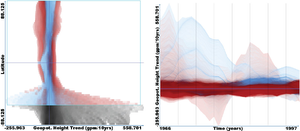Information
- Visibility: hidden
- Publication Type: Article in a Book
- Workgroup(s)/Project(s):
- Date: 2009
- Booktitle: New Horizons in Occultation Research
- Publisher: Springer
- Pages: 235 – 245
Abstract
Climate research often deals with large multi-dimensional fields describing the state of the atmosphere. A novel approach to gain information about these large data sets has become feasible only recently using 4D visualization techniques. The Simulation Visualization (SimVis) software tool, developed by the VRVis Research Center (Vienna, Austria), uses such techniques to provide access to the data interactively and to explore and analyze large three-dimensional time-dependent fields. Non-trivial visualization approaches are applied to provide a responsive and useful interactive experience for the user. In this study we used SimVis for the investigation of climate research data sets. An ECHAM5 climate model run and the ERA-40 reanalysis data sets were explored, with the ultimate goal to identify parameters and regions reacting most sensitive to climate change, representing robust indicators. The focus lies on the upper troposphere-lower stratosphere (UTLS) region, in view of future applications of the findings to radio occultation (RO) climatologies. First results showing the capability of SimVis to deal with climate data, including trend time series and spatial distributions of RO parameters are presented.Additional Files and Images
Weblinks
No further information available.BibTeX
@incollection{Ladstaedter-2009-sim,
title = "SimVis: An Interactive Visual Field Exploration Tool Applied
to Climate Research",
author = "Florian Ladst\"{a}dter and Andrea K. Steiner and Bettina C.
Lackner and Gottfried Kirchengast and Philipp Muigg and
Johannes Kehrer and Helmut Doleisch",
year = "2009",
abstract = "Climate research often deals with large multi-dimensional
fields describing the state of the atmosphere. A novel
approach to gain information about these large data sets has
become feasible only recently using 4D visualization
techniques. The Simulation Visualization (SimVis) software
tool, developed by the VRVis Research Center (Vienna,
Austria), uses such techniques to provide access to the data
interactively and to explore and analyze large
three-dimensional time-dependent fields. Non-trivial
visualization approaches are applied to provide a responsive
and useful interactive experience for the user. In this
study we used SimVis for the investigation of climate
research data sets. An ECHAM5 climate model run and the
ERA-40 reanalysis data sets were explored, with the ultimate
goal to identify parameters and regions reacting most
sensitive to climate change, representing robust indicators.
The focus lies on the upper troposphere-lower stratosphere
(UTLS) region, in view of future applications of the
findings to radio occultation (RO) climatologies. First
results showing the capability of SimVis to deal with
climate data, including trend time series and spatial
distributions of RO parameters are presented.",
booktitle = "New Horizons in Occultation Research",
publisher = "Springer",
URL = "https://www.cg.tuwien.ac.at/research/publications/2009/Ladstaedter-2009-sim/",
}

